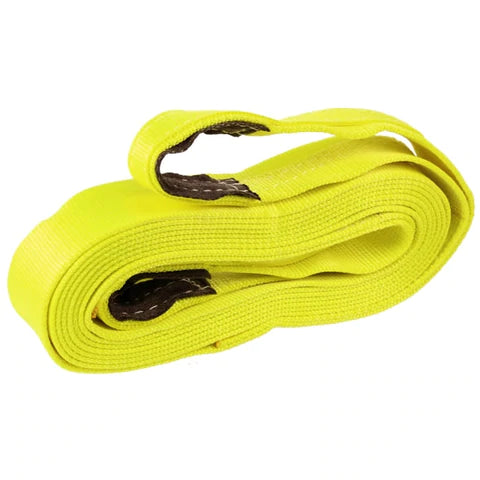
Auto Recovery Straps vs. Tow Straps

We get a lot of questions about which straps to use when hauling and towing a vehicle versus the best straps for recovering cars from ditches or other situations. There is a difference between recovery straps and tow straps, and each type has its benefits.

Situational usage of recovery straps.
Recovery Straps
Recovery straps work best to “recover” a stuck vehicle. Say your car or off-road recreational vehicle gets stuck in the mud or a ditch, stranded no matter how hard you try to get out.
If you don’t want to call a tow truck, you can use another vehicle and recovery straps to do the job. Recovery straps are made of a nylon fabrication that stretches when necessary.
These straps, also called “snatch straps” since they can snatch a vehicle out of a sticky situation, have loops on each end.

To use a recovery strap, you attach it to the back of the vehicle performing the recovery at an appropriate frame point. Attach the other end to the front of the recovered vehicle.
Thread the strap through the eye of the other end to choke the frame. Make sure the strap is not rubbing against any sharp edges.
If you need hardware to secure the strap, anchor shackles are great for recovery vehicles.
As the first vehicle begins to move forward, the strap stretches and pulls the stuck vehicle free.
Recovery straps are safer for this type of usage than chain. These products are easier to use and they are not nearly as heavy.
Making sure your recovery strap is in good shape is very important before using. Any frayed or worn straps increases the likelihood of breakage during a recovery. Straps with faded color are also more apt to break during usage. Store straps out of sunlight and away from excessive heat. Straps perform well in cold temps as well as heat. However, never use these products in temperatures in excess of 194 degrees Fahrenheit.
To clean your strap, spray with water and do not use chemicals.
Tow Straps
The biggest difference between a tow strap and a recovery strap is the stretchiness of the fabric. A tow strap consists of less-stretchy polyester, which hooks on a freely-moving vehicle behind another vehicle. Typically, tow straps have metal hooks on each end.
Tow straps should not be used in the recovery of stuck vehicles simply because they are less stretchy and can more easily break under the pressure a recovery entails. Traditional tow straps and chains are similar in their towing applications.
Strap Safety
No matter which type of strap you’re using, there are standard safety protocols. Because straps can snap, or break, and launch through the air at a high rate of speed, it’s a good idea to keep any bystanders at least the distance of the length of the strap away from the application.
Choosing the right size strap is also very important. US Cargo Control straps come in widths from 2” to 12” with break strengths from 20,000 lbs. to 400,000+ lbs. Customized straps are also available since we manufacture them in-house.
We can also layer the strap from 1- to 4-ply designs, so you can get the width you want with the strength you need. More plies allow for a narrower strap with greater break strength than single ply.
Our straps are designed with CORDURA® at the eyes of the strap for better resistance to wear and tear.
It’s important to note that US Cargo Control straps are manufactured with high-quality, heavy-duty nylon designed for both recovery and towing uses.



